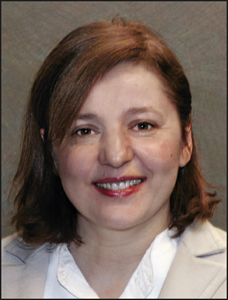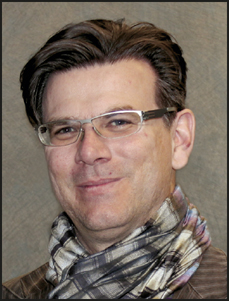Meeting chairs for the 2016 Materials Research Society (MRS) Fall Meeting are Bernard Bewlay (General Electric–Global Research Center, USA), Silvija Gradečak (Massachusetts Institute of Technology, USA), Sarah Heilshorn (Stanford University, USA), Ralph Spolenak (ETH Zürich, Switzerland), and T. Venky Venkatesan (National University of Singapore). The Meeting will be held November 27–December 2, 2016, in Boston, Mass.
Bernard Bewlay is a chief scientist at General Electric–Global Research Center, in Niskayuna, New York. He leads a group developing advanced aircraft engine technologies, with a particular emphasis on aircraft engine durability. He received his BA, MA, and DPhil degrees from the University of Oxford, United Kingdom.

He has extensive experience in high-temperature materials and advanced high-temperature systems. He has focused on structure–property–processing relationships in metallic alloys, ceramics, and coatings, with an emphasis on component design and applications. His research involves both computational and experimental techniques in areas such as materials design, process design, heat transfer, and fluid flow. He holds more than 90 issued patents, with an additional 90 published patent applications, and has published more than 120 articles.
Bewlay’s awards include the ASM International Alfred H. Geisler Award in 1991, the GE Whitney Gallery Award in 1991 and 1998, the GE Global Research Blodgett Award in 2011, the GE Whitney Award in 2010, the GE Aviation William L. Badger Award in 2011, the GE Global Research Charles Greskovich Award in 2009, the Eastern New York Law Association Intellectual Property Award in 2013, and the ASM International Engineering Materials Achievement Award in 2013. He is a member of MRS, TMS, and the Institute of Materials, Minerals and Mining. He has been a Fellow of ASM International since 2000.
Silvija Gradečak is an associate professor of materials science and engineering at Massachusetts Institute of Technology (MIT). After receiving her MS degree in physics from the University of Zagreb, Croatia, in 1999, she moved to Switzerland to pursue her PhD degree in the field of III–V materials and electron microscopy at the École Polytechnique Fédérale de Lausanne (EPFL). In 2003, she obtained her PhD degree in physics and subsequently was awarded the Swiss National Science Foundation Fellowship for Prospective Researchers. After spending two years as a postdoctoral research fellow at Harvard University, USA, she joined the MIT faculty in September 2006.

Gradečak’s interdisciplinary research program is based on the synthesis of materials with confined dimensions, including two-dimensional films, one-dimensional nanowires/nanotubes, and zero-dimensional nanocrystals, and their assembly into functional devices for applications in nanophotonics, nanoelectronics, and in energy harvesting and conversion. To address some of the key challenges in the field of nanomaterials, she combines a set of synthesis and characterization techniques with robust material models and device fabrication. Her honors include a National Science Foundation CAREER Award, 3M Innovation Award, Inaugural 2012 Nano Letters Young Investigator Lectureship, Merton C. Flemings Career Development Chair, Thomas Lord Career Development Chair, and MIT Alumni Fund Award for Teaching and Education Enhancement.
Sarah Heilshorn is an associate professor in the Department of Materials Science and Engineering and, by courtesy, of Bioengineering and Chemical Engineering at Stanford University. She earned a BS degree in chemical engineering at Georgia Institute of Technology (Georgia Tech) in 1998. She completed a MS degree in 2000 and a PhD degree in 2004, both in chemical engineering at California Institute of Technology, and was a visiting scientist at Kyoto Institute of Technology, Japan. Prior to joining Stanford in 2006, she was a postdoctoral scholar in the Department of Molecular and Cell Biology at the University of California–Berkeley.

Heilshorn combines the fields of polymer science and protein engineering to design new materials that mimic those found in our own bodies. These materials are being explored for applications in minimally invasive regenerative medicine, robust self-assembly systems, and human tissue mimetics. Recent recognitions for her research include the National Science Foundation CAREER Award and the National Institutes of Health New Innovator Award. She serves on the Editorial Board of the journal Biomaterials Science and is the chair-elect for the Gordon Research Conference on Signal Transduction from Engineered Extracellular Matrices.
Ralph Spolenak has been a full professor since 2014, chair of the Laboratory for Nanometallurgy since 2004, and serves as the chairman of the board of the Scientific Center for Optical and Electron Microscopy (ScopeM) at ETH Zürich, Switzerland. He served as the director of ETH Zürich’s Materials Research Center for six years.
Spolenak studied physics at the Technical University of Vienna, Austria. He completed his diploma thesis in the field of solid-state physics in 1995, and had a brief research term at the University of Pavia, Italy. In 1999, Spolenak completed his dissertation on alloying effects in electromigration at the Max Planck Institute for Metals Research and the University of Stuttgart, Germany, and was awarded the Max Planck Society’s Otto Hahn Medal. Prior to joining ETH Zürich, he spent time at Bell Laboratories, USA; the Advanced Light Source, Lawrence Berkeley National Laboratory, USA; Lehigh University, USA; and the Max Planck Institute, Germany.

Spolenak’s group focuses on the mechanical properties of metals at the nanoscale and how these properties can be influenced by metallurgical approaches. His own recent research includes switchable semiconducting interference layers in the visible range at the nanometer length scale, color tuning in precious intermetallics, strain engineering to approach the direct bandgap in Ge, microstructure tuning by ion irradiation, size effects in high entropy alloys, and industry projects on coatings for biomedical materials and contact materials.
T. Venky Venkatesan is the director of the Nano Institute at the National University of Singapore, where he is a professor of electrical and computer engineering, materials science and engineering, and physics. Previously, he worked at Bell Laboratories, USA, and Bellcore, USA, for about 17 years before becoming a professor at the University of Maryland for another 17 years. He is the inventor of the pulsed laser deposition (PLD) process. He has published over 650 papers and holds over 30 patents in the area of oxide thin films. He has had over 34 doctoral students, 35 postdoctoral students, and 40 undergraduates. He is also the founder and chairman of Neocera, a company specializing in PLD and magnetic field imaging systems.

Venkatesan is an academician of the Asia Pacific Academy of Materials, member of the Physics Policy Committee in Washington, DC, guest professor at Tsinghua University in China, member of the Board of Visitors at the University of Maryland, and the chairman of the American Physical Society’s (APS) Forum of Industry and Applications of Physics. He is the recipient of the Bellcore Award of Excellence, the APS George E. Pake Prize in 2012, and the President’s Gold Medal of the Institute of Physics Singapore. He is a Fellow of APS and of the World Innovation Forum.


